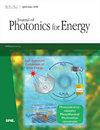Patterning of plasmonic Au nanoparticles on the surfaces of TiOx thin films by solid state thermal dewetting
IF 2.1
4区 工程技术
Q4 MATERIALS SCIENCE, MULTIDISCIPLINARY
引用次数: 0
Abstract
Abstract. It is essential to study the thermal dewetting behavior of as-deposited nano-films for large scale and high-throughput fabrication. We report here on the nucleation of Au nanostructures onto titanium dioxide (TiOx) thin films surfaces, which occurred in consecutive steps. First, TiOx thin films were grown on quartz substrates reactively by e-beam evaporator and then thermally annealed at different temperatures, starting from 300°C to 900°C. Subsequently, a nano-film of Au was deposited on the top of these TiOx surfaces. The stacked Au / TiOx samples were post-annealed using muffle furnace at a temperature of 600°C for 1 h, to study the thermal dewetting properties and the controlled growth of the different TiOx morphologies on the formation of Au nanoparticles (NP) and their plasmonic response. Such dual-structures were characterized accordingly to probe their topological, morphological, structural, and optical properties, by means of x-ray photoelectron spectroscopy, scanning electron microscope, atomic force microscopy, and ultra-violet–visible–near infrared characterization techniques. The thermal dewetting properties were found to improve at high temperatures (>500 ° C), where the Au NP size distribution was found to follow a Gaussian pattern centered around 30 nm. The average surface roughness also increased significantly with respect to the TiOx dewetting temperature, which is mainly attributed to the porosity of the films. Finally, the absorption peak for Au nanostructures has shown a localized surface plasmon resonance close to 520 nm, along with a broad shoulder peak with a strong tail thereby reflecting the wide distribution of the formed Au NP sizes.用固态热脱湿法在TiOx薄膜表面制备等离子体金纳米颗粒
摘要研究沉积态纳米薄膜的热脱湿行为对于大规模、高通量的制备至关重要。我们在这里报道了Au纳米结构在二氧化钛(TiOx)薄膜表面的成核,这是以连续的步骤发生的。首先,通过电子束蒸发器在石英衬底上反应生长TiOx薄膜,然后在300°C至900°C的不同温度下进行热退火。随后,在这些TiOx表面的顶部沉积Au的纳米膜。堆叠的Au / 使用马弗炉在600°C的温度下对TiOx样品进行1小时的后退火,以研究不同TiOx形态对Au纳米颗粒(NP)形成及其等离子体响应的热脱湿性能和可控生长。通过x射线光电子能谱、扫描电子显微镜、原子力显微镜和紫外线-可见光-近红外表征技术,对这种双结构进行了相应的表征,以探测其拓扑、形态、结构和光学性质。发现在高温下(>500 ° C) ,其中发现Au NP尺寸分布遵循以30nm为中心的高斯图案。平均表面粗糙度也随着TiOx脱湿温度的升高而显著增加,这主要归因于薄膜的孔隙率。最后,Au纳米结构的吸收峰显示出接近520nm的局部表面等离子体共振,以及具有强尾部的宽肩峰,从而反映了形成的Au NP尺寸的宽分布。
本文章由计算机程序翻译,如有差异,请以英文原文为准。
求助全文
约1分钟内获得全文
求助全文
来源期刊

Journal of Photonics for Energy
MATERIALS SCIENCE, MULTIDISCIPLINARY-OPTICS
CiteScore
3.20
自引率
5.90%
发文量
28
审稿时长
>12 weeks
期刊介绍:
The Journal of Photonics for Energy publishes peer-reviewed papers covering fundamental and applied research areas focused on the applications of photonics for renewable energy harvesting, conversion, storage, distribution, monitoring, consumption, and efficient usage.
 求助内容:
求助内容: 应助结果提醒方式:
应助结果提醒方式:


